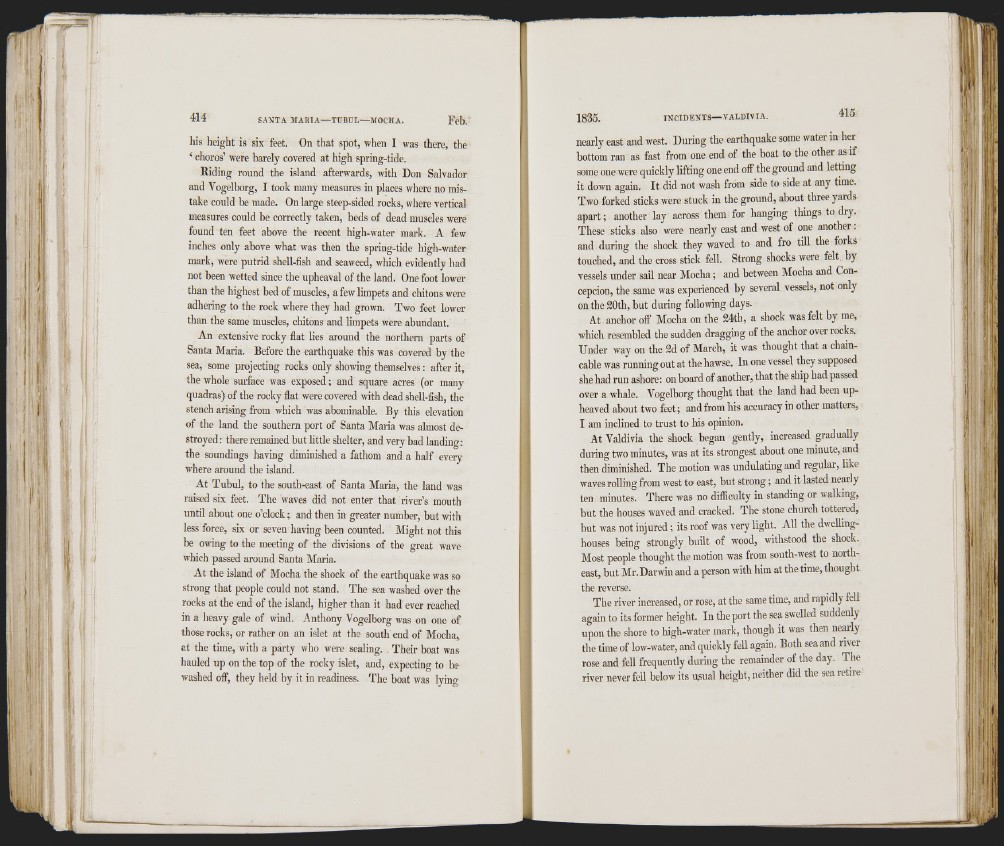
his height is six feet. On that spot, when I was there, tlie
‘ choros’ were barely covered at high spring-tide.
Siding round the island afterwards, with Don Salvador
and Vogelborg, I took many measures in places where no mistake
could be made. On large steep-sided rocks, where vertical
measures could be correctly taken, beds of dead muscles were
found ten feet above the recent high-water mai-k. A few
inches only above what was then the spring-tide high-water
mark, were putrid shell-fish and seaweed, which evidently had
not been wetted since the upheaval of the land. One foot lower
than the highest bed of muscles, a few limpets and chitons were
adhering to the rock where they had grown. Two feet lower
than the same muscles, chitons and limpets were abundant.
An extensive rocky fiat lies around the northern parts of
Santa Maria. Before the earthquake this was covered by the
sea, some projecting rocks only showing themselves: after it,
the whole surface was exposed; and square acres (or many
quadras) of tlie rocky flat were covered with dead shell-fish, the
stench arising from which was abominable. By this elevation
of the land the southern port of Santa Maria was almost destroyed:
there remained but little shelter, and very bad landing:
the soundings having diminished a fathom and a half every
where around the island.
At Tubul, to the south-east of Santa Maria, the land was
raised six feet. The waves did not enter that river’s mouth
until about one o’clock ; and then in greater number, but with
less force, six or seven having been counted. Might not this
be owing to the meeting of the divisions of the great wave
which passed around Santa Maria.
At the island of Mocha the shock of the earthquake was so
strong that people could not stand. The sea washed over the
rocks at the end of the island, higher than it had ever reached
in a heavy gale of wind. Anthony Vogelborg was on one of
those rocks, or rather on an islet at the south end of Mocha,
at the time, with a party who were sealing. Their boat was
hauled up on the top of the rocky islet, and, expecting to be
washed off", they held by it in readiness. The boat was lying
nearly east and west. During the earthquake some water in her
bottom ran as fast from one end of the boat to the other as if
some one were quickly lifting one end off the ground and letting
it down again. I t did not wash from side to side at any time.
Two forked sticks were stuck in the ground, about three yards
apart; another lay across them for hanging things to dry.
These sticks also were nearly east and west of one another:
and during the shock they waved to and fro till the forks
touched, and the cross stick fell. Strong shocks were felt by
vessels under sail near Mocha; and between Mocha and Concepcion,
the same was experienced by several vessels, not only
on the 20th, but during following days.
At anchor off Mocha on the 24th, a shock was felt by me,
which resembled the sudden dragging of the anchor over rocks.
Under way on the 2d of March, it was thought that a chain-
cahle was running out at the hawse. In one vessel they supposed
she had run ashore: on board of another, that the ship had passed
over a whale. Vogelborg thought that the land had been upheaved
about two feet; and from his accuracy in other matters,
I am inclined to trust to his opinion.
At Valdivia the shock began gently, increased gradually
during two minutes, was at its strongest about one minute, and
then diminished. The motion was undulating and regular, like
waves rolling from west to east, but strong; and it lasted nearly
ten minutes. There was no difficulty in standing or walking,
but the houses waved and cracked. The stone church tottered,
but was not injured ; its roof was very light. All the dwelling-
houses being strongly built of wood, witlistood the shock.
Most people thought the motion was from south-west to northeast,
but Mr.Darwin and a person with him at the time, thought
the reverse.
The river increased, or rose, at the same time, and rapidly fell
again to its former height. In the port the sea swelled suddenly
upon the shore to high-water mark, though it was then nearly
the time of low-water, and quickly fell again. Both sea and river
rose and fell frequently during the remainder of the day. The
river never fell below its usual height, neither did the sea retire
l l ?